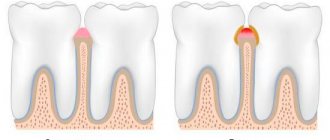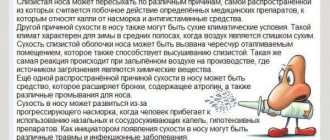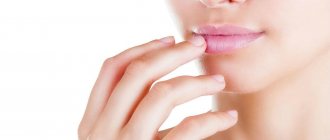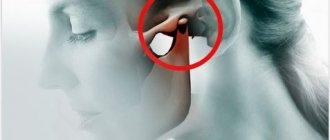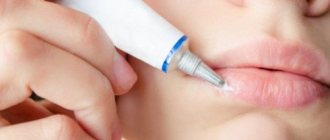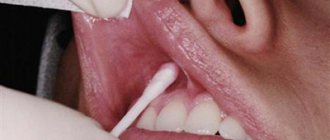Why does my mouth start to burn?
In the ICD, burning mouth syndrome is called glossodynia. This can be an independent diagnosis or a symptom that accompanies another disease. Researchers have not found a single reason why your mouth suddenly feels scalded.
After many tests, the diagnosis is often given the word “primary” or “idiopathic”. This means that the cause of the burning pain in the mouth could not be found. There is a hypothesis that the basis of the disease is damage to sensory and pain receptors.
Among the causes of secondary glossodynia are:
- gastroesophageal reflux, also known as GERD;
- allergies to food, mouthwash, or denture material;
- hormonal changes due to hypothyroidism, diabetes, or menopause;
- dry mouth as a result of radiation therapy or due to “breakage” of the salivary glands;
- high blood pressure medications such as enalapril, perindopril and others;
- lack of iron, zinc and B vitamins;
- excessive cleaning of the tongue, especially with abrasive pastes;
- fungal infections of the mouth.
Burning tongue. Possible reasons
The causes may be congenital or acquired, associated with infections, intoxications, injuries to the nervous system and disorders of its blood supply, psychogenic, caused by a lack of vitamin PP in intestinal diseases.
A burning sensation of the tongue is often observed with arthrosis of the temporomandibular joint.
Glossalgia can occur with malocclusion, with sharp edges of teeth and dentures, fillings and dentures made of different metals, after traumatic tooth extraction.
Burning syndrome in the mouth is observed in chronic gastritis with secretory insufficiency (reduced gastric secretion), intestinal diseases (enteritis, colitis), and diseases of the liver and biliary tract. Treating these conditions can significantly reduce burning mouth syndrome.
Most often, this syndrome is observed in women aged 50–60 years. The main signs of burning mouth syndrome are the following sensations:
- tingling,
- tingling,
- pressure,
- numbness,
- burning tongue,
In this case, there is a coating on the surface of the tongue and dry mouth.
How to put out a fire in your mouth?
If a burning sensation in the mouth accompanies the underlying disease, then eliminating the disease should relieve the unpleasant symptoms. Treatment for primary burnt mouth syndrome is more like a series of experiments. The British National Health Service advises to accept that the treatment process may take years.
Ways to relieve mild burning include:
- moisturizing mouth sprays, otherwise called saliva substitutes;
- lidocaine-based rinses;
- regular cool drinks;
- avoiding acidic foods, spicy foods and alcohol;
- using toothpaste for sensitive teeth;
- combating stress and anxiety: yoga, meditation, cognitive behavioral therapy.
Severe, burning pain in the mouth is treated like any other chronic pain: with anticonvulsants or low-dose antidepressants.
Treatment of burning sensation in the mouth
Therapeutic nutrition, exclusion of spicy and irritating foods.
- After consultation with a dentist, elimination of foci of pathological impulses in the oral cavity from the dentofacial system.
- Normalization of the tone of the autonomic nervous system:
- preparations of valerian, motherwort, bellataminal, etc.,
- tissue metabolism stimulants - courses of B vitamins (B1, B6, B12),
- nootropic drugs, depending on the nature of the neuropsychic disorders (tranquilizers, antidepressants and other drugs that improve blood supply to the brain and oral tissues). The course of treatment must be carried out after consultation with a neurologist.
- Local remedies: applications to the tongue of a 2% novocaine solution, 10% lidocaine solution, rinsing with propolis, herbal infusion.
- In some cases, physiotherapy is used - electrophoresis on the solar plexus and cervical autonomic nodes, hirudotherapy from a specialist.
Modern etiological and clinical aspects of burning mouth syndrome
O. V. Shurygina
Candidate of Medical Sciences, Associate Professor, Department of Dentistry, Samara Medical Institute "REAVIZ"
A. V. Shumsky
Professor, Head of the Department of Dentistry, Samara Medical Institute "REAVIZ"
Burning mouth syndrome (BOS) is a chronic disease, the main manifestation of which is orofacial pain, usually not accompanied by damage to the oral mucosa and tongue [1, 4]. In addition to SZhPR, there are a large number of terms (over ten) that denote real suffering. The most commonly used are glossalgia, glossodynia and stomalgia [5].
The etiopathogenesis of burning mouth syndrome (BMS) is still unclear, and this issue is a matter of considerable controversy in the literature. The main difficulty of the problem is that CVD can be a complex of numerous diseases with overlapping symptoms. Consequently, symptomatic therapy without paying attention to the etiology causes many problems in diagnosis and treatment [7, 13, 14].
As a result of the examination of patients, it was revealed that local and general factors are distinguished in the occurrence and development of CVD.
Local factors
- Galvanosis
Most modern materials for the manufacture of inlays and dentures are not indifferent to the human body. The presence of crowns made of different metals in the oral cavity leads to the appearance of subjective symptoms in patients. Patients complain of a metallic taste, burning, tingling in the mouth, distortion of taste sensitivity, and a sensation of different tastes.
2. The most common factor is defective dentures.
Errors in the manufacture of a removable denture lead to incorrect movement of the base over the underlying mucous membrane. This limits the normal functioning of the lingual muscles and contributes to the phenomenon of a burning sensation.
- Reduced occlusal bite height
The irreversible consequence is a change in the position of the condylar processes of the lower jaw in relation to the articular cavities of the temporal bone.
Costen in 1936 published information about the syndrome, usually referred to by his name, in which a decrease in the occlusal height of the lower part of the face leads to the development of arthrosis in the temporomandibular joints, which leads to the formation of malocclusion. This is observed with pathological abrasion of teeth and periodontal disease.
The author explains the neurological symptoms by compression of the eustachian tube and traumatization of the auriculotemporal nerve and chorda tympani, given that the petrotympanic fissure is located deep in the posterior part of the fossa of the temporomandibular joint. In this case, patients experience paroxysms of facial pain, clicking in the joint, sensations of congestion in the ears, burning and paresthesia of the tongue, and dry mouth.
Another component of the factor reducing the height of the bite is the disruption of the masticatory muscles. The posterior group of masticatory muscles, which ensures the closure of the mouth, is always in a state of spasm due to the need to constantly ensure work in the wrong position.
4. Research indicates that many patients with HSDD exhibit parafunctional habits (tongue thrusting, bruxism, teeth clenching).
Parafunctional activity is influenced by various external factors, such as stressful life events and alcohol abuse.
5. The literature describes cases of the appearance of paresthesia during traumatic extraction of teeth, their preparation during orthopedic manipulations, diseases of the oral mucosa - candidiasis, lichen planus.
General factors
- There is a shocking connection between FMDV and pre-/post-menopausal stages.
About 90% of women who attend clinics because of symptoms of CVD are menopausal.
The relationship between diabetes mellitus and CVD is controversial. It has been suggested that type 2 diabetes mellitus plays a role in the development of CVD, and a link has been suggested between the type of insulin used to treat diabetes and CVD.
2. Nutritional deficiency, in particular lack of B vitamins
Insufficient intake of vitamins B1 and B2 is accompanied by changes in the oral mucosa, and its resistance to the effects of Candida fungi decreases. Riboflavin deficiency is manifested by angular stomatitis, glossitis and specific pigmentation of the tongue, burning in the mouth.
Vitamin B6 deficiency (pyrodoxine) is manifested by skin lesions in the mouth area. Insufficient intake of vitamin B12 (cyanocobalamin) is accompanied by a number of neurological symptoms, the manifestation of which in the oral cavity is a burning sensation of the tongue. Pathological mitotic activity with a lack of vitamin B12 affects the process of hematopoiesis, which significantly reduces both local and general immunity. SZhPR patients show low levels of vitamins B1, B6, B12 in their blood serum.
The listed effects of hypovitaminosis of B vitamins determine their correction during the treatment of CVD.
3. Psychogenic factors (stress)
Psychological and emotional factors play an important role in both the occurrence and maintenance of CVD. Often, CVD appears after emotional trauma, death or cancer of a loved one, or during personal and professional difficulties.
Changes in the psychological status were detected in all patients with SZhPR.
Many patients with GSPD demonstrate high levels of anxiety and depression, as well as pain relief after appropriate use of psychotropic medications such as depressants and benzodiazepines. However, there is increasing controversy as to whether depression and anxiety are primary or secondary manifestations of oral pain [8]. It is noteworthy that psychological dysfunction is common among patients with a wide range of different types of chronic pain conditions. No connection was found between the development of CVD and stressful life events. In addition, depression and anxiety may not be present in patients with GIB and there may be only a small amount of disruption in their normal activities due to oral burning.
Emotional disorders are so often combined with CVD that a number of authors point to the leading role of psychological factors in the development of this pathology. [9, 10, 11].
Mental disorders are an integral component of the clinical manifestations of GSPD. The most common are anxiety, depression, hypochondria and sleep disorders. Mental changes in patients with GSPD have a wide range and range from minor disorders to severe mental disorders, which must be taken into account when conducting therapy [2, 6, 10].
- According to many authors, in some cases, glossalgia occurs in diseases of the digestive system (gastritis, gastric ulcer), endocrine disorders (diabetes, menopause), metabolic-dystrophic changes in the cervical spine (atherosclerosis) [1, 3].
Clinical manifestations of burning mouth syndrome
GSPR describes a range of chronic oral symptoms that include oral pain, dysgesia (taste disturbance) and xerostomia (dry mouth) [12, 13].
- Oral pain is the main symptom of GSPR. The type of pain experienced by patients with GSPR is a prolonged burning sensation and lack of sensation in the mouth.
The onset of oral pain is usually spontaneous. However, some patients with GSPD attribute the onset of pain to previous events, such as dental procedures (especially traumatic tooth extraction, dental preparation for orthopedic interventions), or other diseases. Pain levels range from mild to severe, but moderate pain is more common. Most often, the pain is localized in the anterior two-thirds of the tongue, on the lower lip and hard palate. Speaking about the location of the pain, it should be noted that some patients with GSPR experience other types of pain along with oral burning (headache, pain in the temporomandibular joint and masticatory muscles). According to the nature of the pain, patients with CVD are divided into 3 types.
In patients with type 1 GIPD, pain develops in the morning, gradually increases during the day and reaches its peak intensity in the evening. This type is associated with systemic disorders such as nutritional deficiency, diabetes, etc.
Patients with type 2 SZHPR complain of continuous symptoms throughout the day. These patients report frequent mood swings, changes in eating habits, and a decreased desire to socialize. Due to constant burning in the mouth, these patients have trouble sleeping.
In patients with type 3 GIPR, pain and burning in the oral cavity are not constant (there are periods without pain).
2. Divgesia
70% of patients with SGPD have a persistent taste disorder. The most common taste is bitter, metallic, or both.
Various changes in taste perception appear at either threshold or suprathreshold levels. At threshold concentrations, patients with GISD may perceive sweet solutions less intensely, while at suprathreshold concentrations, the ability to taste sweet and sour may increase.
3. Xerostomia
About 45-65% of patients with GIPD complain of dry mouth. This can be caused by both subjective and objective reasons.
Subjective xerostomia in patients with GSPR is often associated with psychological problems such as depression, or with the abuse of psychotropic, antihistamine, and diuretic drugs.
Objective xerostomia in patients with GSPR is associated with dysfunction of the salivary glands. Some patients with GIPD who complain of dry mouth may experience changes in the quantity and quality of saliva. Reduced salivary flow rates are common, while changes in salivary composition may vary.
There are 3 degrees of xerostomia.
1st degree - no dryness. There are only unpleasant sensations on the tongue and oral mucosa.
The mucous membrane is moderately moistened; when massaging the salivary glands, clear saliva is released.
2nd degree - patients constantly complain of dry mouth, especially while eating. The oral mucosa is dry and of normal color. From the ducts there is a meager amount of saliva.
The 3rd degree is characterized by the absence of saliva, inflammation of the mucous membrane, with cracks and ulceration, multiple caries, and stomatitis.
Thus, burning mouth syndrome (BMS) remains an interesting condition in the field of dentistry. New evidence is emerging for the neuropathic basis of this pathology. Treatment of patients with CVD should be comprehensive and carried out jointly by dentists and neurologists.
